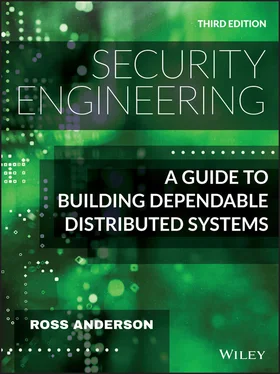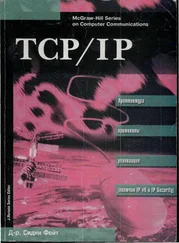Most attacks nowadays exploit the implementation. In chapter 2, I mentioned the scandal of NIST standardising a complicated random number generator based on elliptic curves that turned out to contain an NSA backdoor; see section 2.2.1.5. Poor random number generators have led to many other failures: RSA keys with common factors [1142], predictable seeds for discrete logs [1679], etc. These vulnerabilities have continued; thanks to the Internet of Things, the proportion of RSA certs one can find out there on the Internet that share a common factor with other RSA keys has actually risen between 2012 and 2020; 1 in 172 IoT certs are trivially vulnerable [1048].
Many of the practical attacks on cryptographic implementations that have forced significant changes over the past 20 years have exploited side channels such as timing and power analysis; I devote Chapter 19to these.
In Chapter 20, I'll discuss a number of systems that use public-key mechanisms in intricate ways to get interesting emergent properties, including the Signal messaging protocol, the TOR anonymity system, and cryptocurrencies. I'll also look at the crypto aspects of SGX enclaves. These also have interesting failure modes, some but not all of them relating to side channels.
In Chapter 21, I'll discuss protocols used in network infrastructure such as DKIM, DNSSec versus DNS over HTTP, and SSH.
Many ciphers fail because they're used badly, so the security engineer needs a clear idea of what different types of cipher do. This can be tackled at different levels; one is at the level of crypto theory, where we can talk about the random oracle model, the concrete model and the semantic security model, and hopefully avoid using weak modes of operation and other constructions. The next level is that of the design of individual ciphers, such as AES, or the number-theoretic mechanisms that underlie public-key cryptosystems and digital signature mechanisms. These also have their own specialised fields of mathematics, namely block cipher cryptanalysis and computational number theory. The next level involves implementation badness, which is much more intractable and messy. This involves dealing with timing, error handling, power consumption and all sorts of other grubby details, and is where modern cryptosystems tend to break in practice.
Peering under the hood of real systems, we've discussed how block ciphers for symmetric key applications can be constructed by the careful combination of substitutions and permutations; for asymmetric applications such as public key encryption and digital signature one uses number theory. In both cases, there is quite a large body of mathematics. Other kinds of ciphers – stream ciphers and hash functions – can be constructed from block ciphers by using them in suitable modes of operation. These have different error propagation, pattern concealment and integrity protection properties. A lot of systems fail because popular crypto libraries encourage programmers to use inappropriate modes of operation by exposing unsafe defaults. Never use ECB mode unless you really understand what you're doing.
There are many other things that can go wrong, from side channel attacks to poor random number generators. In particular, it is surprisingly hard to build systems that are robust even when components fail (or are encouraged to) and where the cryptographic mechanisms are well integrated with other measures such as access control and physical security. I'll return to this repeatedly in later chapters.
The moral is: Don't roll your own! Don't design your own protocols, or your own ciphers; and don't write your own crypto code unless you absolutely have to. If you do, then you not only need to read this book (and then read it again, carefully); you need to read up the relevant specialist material, speak to experts, and have capable motivated people try to break it. At the very least, you need to get your work peer-reviewed. Designing crypto is a bit like juggling chainsaws; it's just too easy to make fatal errors.
There are many active threads in cryptography research. Many of them are where crypto meets a particular branch of mathematics (number theory, algebraic geometry, complexity theory, combinatorics, graph theory, and information theory). The empirical end of the business is concerned with designing primitives for encryption, signature and composite operations, and which perform reasonably well on available platforms. The two meet in the study of subjects ranging from cryptanalysis, to the search for primitives that combine provable security properties with decent performance.
The best way to get a flavor of what's going on at the theoretical end of things is to read the last few years’ proceedings of research conferences such as Crypto, Eurocrypt and Asiacrypt; work on cipher design appears at Fast Software Encryption; attacks on implementations often appear at CHES; while attacks on how crypto gets used in systems can be found in the systems security conferences such as IEEE Security and Privacy, CCS and Usenix.
The classic papers by Whit Diffie and Martin Hellman [556] and by Ron Rivest, Adi Shamir and Len Adleman [1610] are the closest to required reading in this subject. Bruce Schneier's Applied Cryptography [1670] covers a lot of ground at a level a non-mathematician can understand, and got crypto code out there in the 1990s despite US export control laws, but is now slightly dated. Alfred Menezes, Paul van Oorshot and Scott Vanstone's Handbook of Applied Cryptography [1291] is one reference book on the mathematical detail. Katz and Lindell is the book we get our students to read for the math. It gives an introduction to the standard crypto theory plus the number theory you need for public-key crypto (including elliptic curves and index calculus) but is also dated: they don't mention GCM, for example [1025].
There are many more specialist books. The bible on differential cryptanalysis is by its inventors Eli Biham and Adi Shamir [246], while a good short tutorial on linear and differential cryptanalysis was written by Howard Heys [897]. Doug Stinson's textbook has another detailed explanation of linear cryptanalysis [1832]; and the modern theory of block ciphers can be traced through the papers in the Fast Software Encryption conference series. The original book on modes of operation is by Carl Meyer and Steve Matyas [1303]. Neal Koblitz has a good basic introduction to the mathematics behind public key cryptography [1062]; and the number field sieve is described by Arjen and Henrik Lenstra [1143]. For the practical attacks on TLS over the past twenty years, see the survey paper by Christopher Meyer and Joerg Schwenk [1304] as well as the chapter on Side Channels later in this book.
If you want to work through the mathematical detail of theoretical cryptology, there's an recent graduate textbook by Dan Boneh and Victor Shoup [288]. A less thorough but more readable introduction to randomness and algorithms is in [836]. Research at the theoretical end of cryptology is found at the FOCS, STOC, Crypto, Eurocrypt and Asiacrypt conferences.
The history of cryptology is fascinating, and so many old problems keep on recurring that anyone thinking of working with crypto should study it. The standard work is Kahn [1003]; there are also compilations of historical articles from Cryptologia [529–531] as well as several books on the history of cryptology in World War II by Kahn, Marks, Welchman and others [440, 1004, 1226, 2011]. The NSA Museum at Fort George Meade, Md., is also worth a visit, but perhaps the best is the museum at Bletchley Park in England.
Finally, no chapter that introduces public key encryption would be complete without a mention that, under the name of ‘non-secret encryption,’ it was first discovered by James Ellis in about 1969. However, as Ellis worked for GCHQ, his work remained classified. The RSA algorithm was then invented by Clifford Cocks, and also kept secret. This story is told in [626]. One effect of the secrecy was that their work was not used: although it was motivated by the expense of Army key distribution, Britain's Ministry of Defence did not start building electronic key distribution systems for its main networks until 1992. And the classified community did not pre-invent digital signatures; they remain the achievement of Whit Diffie and Martin Hellman.
Читать дальше











